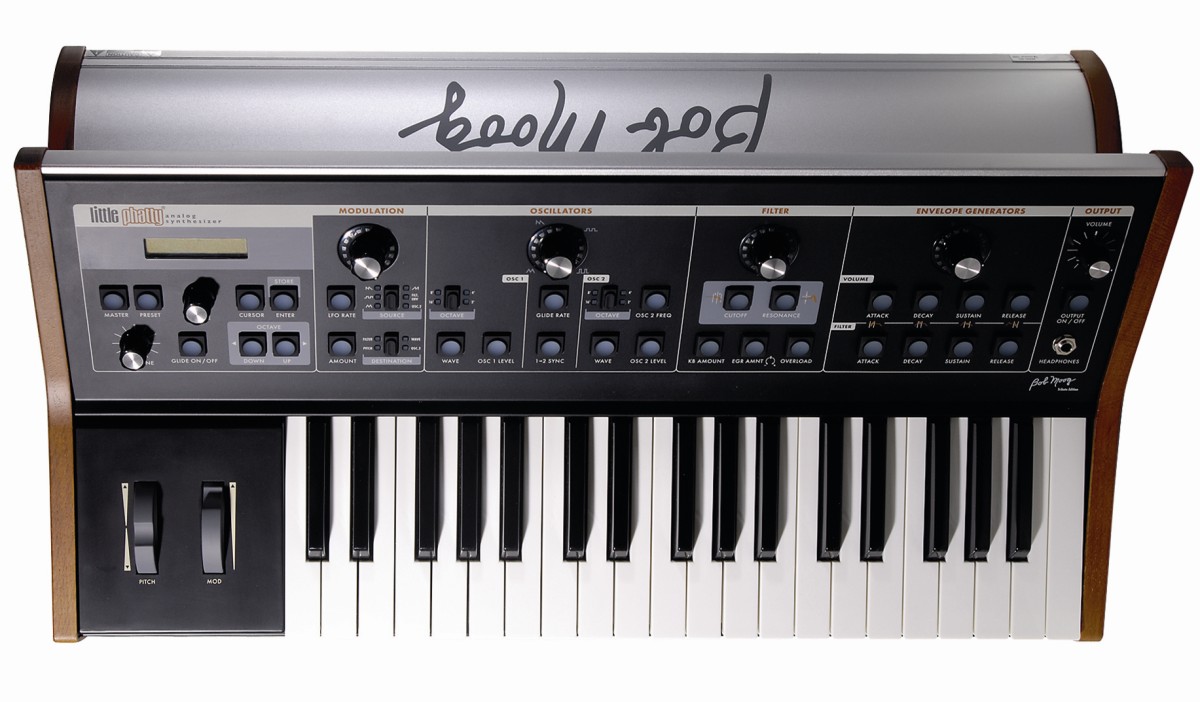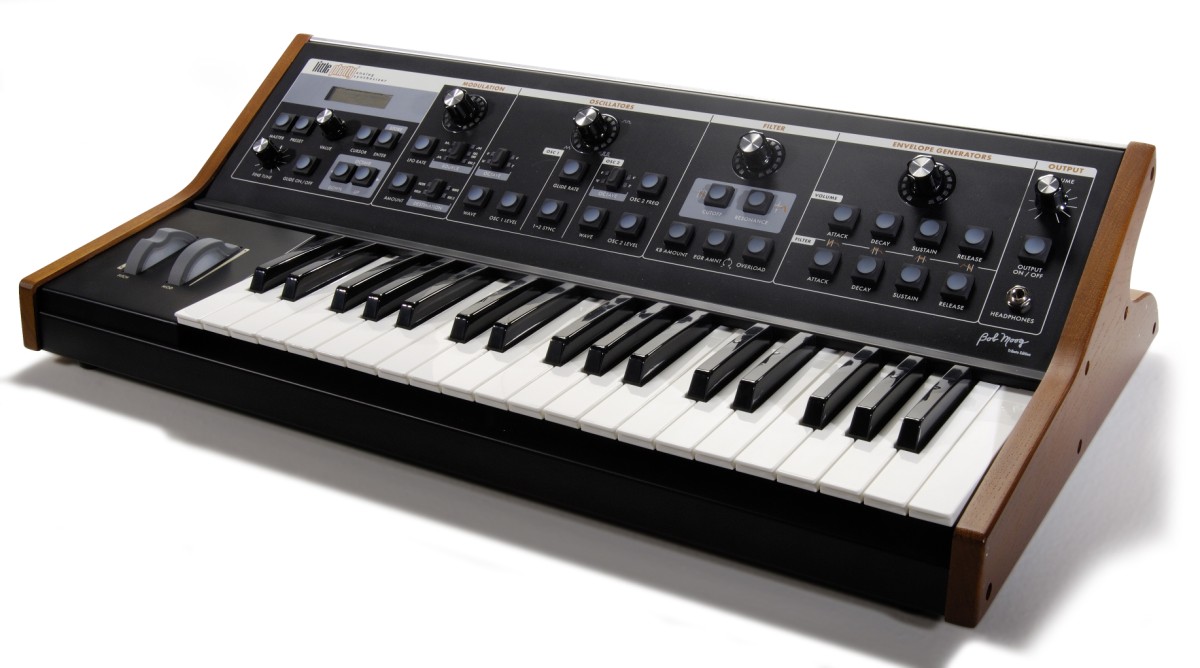MusicRadar Verdict
The original and still the best, this is everything you'd expect of a Moog. Simple as that.
Pros
- +
Gorgeous sounds. Terrific usability. The Moog pedigree. Great price.
Cons
- -
Not a lot at this price.
MusicRadar's got your back

Moog Little Phatty

Moog Little Phatty

Moog Little Phatty
The massive influence of Bob Moog on most pieces of synth gear sitting in your studio should not be underestimated. He was a genuine legend of the music world.
The last project over which he presided over before he died in 2005 was the Little Phatty Tribute Edition, an affordable product designed to bring the classic Moog sound to more studios.
Hands on
So what exactly are we dealing with here? Well, the Little Phatty is an analogue monosynth in the tradition of the Minimoog.
It's built around a three-octave keyboard and, behind that, a raised panel that houses all of the knobs and switches that let you at the sound.
Synthesizers, and particularly Moogs, will always be judged on the noise they make.
Throw in all the arpeggiators, real-time performance controllers and effects sections you want, if the core sound doesn't cut it then you may as well forget about it.
We're delighted to report that the Little Phatty could happily pick a fight with any of its synth contemporaries right now and be assured of bloodying its collective nose.
The sound structure is now legendary. The two VCOs can draw from a pool of four waveforms, which are continuously variable from Triangle, to Sawtooth, to Square to Rectangular waves.
That means that if the rotary encoder that selects your waveform lies between two waves, you'll get a blend of both, which in turn allows for the possibility of pulse width modulation between the Square and Rectangle waves.
Oscillator Two is tuned relative to Oscillator One with an offset of up to seven semitones achievable up or down.
The waveforms can be sync'd for a potentially monstrous sound, while glide can also be applied with variable rate.
The filter, too, is classic Moog. It's a 24dB/octave, resonant affair with dials for Cutoff, Resonance, Keyboard amount, Envelope Generator amount and Overload.
For those unfamiliar with these latter terms, a positive Keyboard amount setting forces the filter to open as you play higher up the keyboard.
The EG amount selects how the filter envelope will shape the brightness of the sound over time, while the Overload sets an amount of signal clipping, adding anything from a little bite to full on speaker-busting distortion.
Envelopes and modulation
The sound is then shaped by envelope settings for the amplifier and filter sections.
The envelopes are governed by traditional Attack, Decay, Sustain and Release sections and editing these is very straightforward.
If you want to modify the amplifier attack time, for example, simply press the appropriate button and its value will be displayed on the rotary encoder above it.
The soft blue light that exists in the centre of every button allows you to keep tabs on exactly where you are.
So even though the Envelope Generator encoder can display any one of eight parameters, it's obvious which one you're looking at.
The output section is simple, with a volume control, an always-on headphone port and a switch to route sound to the physical mono line-out on the side panel. This glows a satisfying pink colour when selected.
The LFO Modulation section is also simplicity itself. One switch for LFO source shape (with six choices), a rate dial with rotary encoder, a switch for the destination of the LFO and an amount switch, which also uses the encoder as its graphic.
One nice touch is that the LFO source LED flashes at the selected rate - rotary encoders are good for most things, but not for showing LFO speeds!
The master section features octave up and down buttons, the glide on/off switch, master tune and an encoder for scrolling through the presets.
All of which brings us neatly on to the sounds themselves.
They simply ooze class. As so many hard and soft synths offer factory patches with Moog references in the title, its easy to wonder what all the fuss is about.
It's not until you've got a real Moog sitting in front of you that you see just how great these boxes really are.
Despite the simple architecture, this unit can produce sumptuous warm bass, bouncy synth sequences, resonant drones and ear-splitting leads in equal measure, plus everything in between.
Okay, it's a monosynth, so that provides its own limitations, but if you're into techy music of any sort, there's plenty here for you.
The 99 preset sounds provide a useful starting point, but it's hard to select one of these and not immediately reach for its dials.
Playing live
Moog always designed his synths with performance in mind, and while the Little Phatty isn't strictly a live tool, there are a number of features designed for onstage use.
The pitch-bend wheel is programmable to operate over a two-octave range, whilst the mod wheel provides vibrato for you.
The Little Phatty can also be programmed to organise presets or sounds you've saved in any order you choose, so you can switch sounds midsong without having to keep dialing up and down.
The manual is clear and incisive, with a great tutorial, which will appeal to teachers.
The accompanying DVD contains a touching dedication to Dr Bob Moog by his wife and audio clips, some of Bob's published papers and an extract from the official documentary of the man.
Summary
Bob Moog defined subtractive synthesis - it's a simple, endlessly varying model that's capable of such a huge spectrum of sounds, it's hard to believe they can be produced by a single instrument.
Most synthesizers, even those drowning in knobs, are still synthesizers.
Moog managed to build musical tools that encouraged precise tweaks and, dare I say it, practice, in the instrument tradition.
The LP is a great release for Moog Music, it continues Bob's legacy, while hinting that their products won't always be aimed at the wealthy minority from now on.
It's good to know Bob oversaw development of Little Phatty before he died. It's clearly his instrument and we're sure he'd be proud of it.
How should we remember him? In a way encouraged by sound '00' in the preset bank: 'Thank You Bob'.
Future Music is the number one magazine for today's producers. Packed with technique and technology we'll help you make great new music. All-access artist interviews, in-depth gear reviews, essential production tutorials and much more. Every marvellous monthly edition features reliable reviews of the latest and greatest hardware and software technology and techniques, unparalleled advice, in-depth interviews, sensational free samples and so much more to improve the experience and outcome of your music-making.
“Chris, that’s not how it goes”: Chris Martin does his best Bruno Mars impression as Rosé joins Coldplay on stage to perform APT in South Korea
“OMG the cops are shutting us down!”: Lorde’s impromptu New York Washington Square Park gig just got axed by police
"Fender will not get preferential treatment": Reverb has been sold by Etsy to investors in Fender and SoundCloud - but says its partnership with the guitar manufacturer "remains unchanged"










